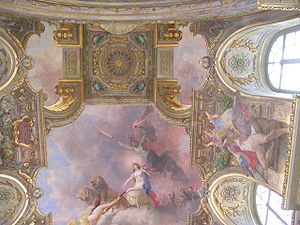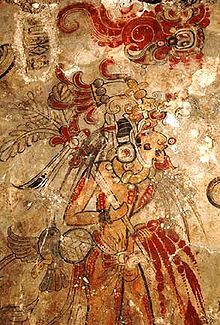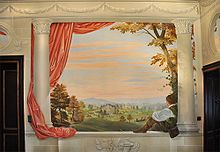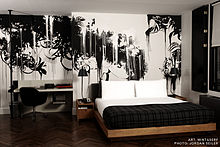- Mural
-
For other uses, see Mural (disambiguation).
 Ceiling painting, by Jean-André Rixens. Salle des Illustres, Le Capitole, Toulouse, France.
Ceiling painting, by Jean-André Rixens. Salle des Illustres, Le Capitole, Toulouse, France.
A mural is any piece of artwork painted or applied directly on a wall, ceiling or other large permanent surface. A particularly distinguishing characteristic of mural painting is that the architectural elements of the given space are harmoniously incorporated into the picture.
Contents
History
Murals of sorts date to Upper Paleolithic times such as the paintings in the Chauvet Cave in Ardèche department of southern France (around 30,000 BC). Many ancient murals have survived in Egyptian tombs (around 3150 BC),[1] the Minoan palaces (Middle period III of the Neopalatial period, 1700-1600 BC) and in Pompeii (around 100 BC - AD 79).
In modern times, the term became more well-known with the Mexican "muralista" art movement (Diego Rivera, David Siqueiros, or José Orozco). There are many different styles and techniques. The best-known is probably fresco, which uses water-soluble paints with a damp lime wash, a rapid use of the resulting mixture over a large surface, and often in parts (but with a sense of the whole). The colors lighten as they dry. The marouflage method has also been used for millennia.
Murals today are painted in a variety of ways, using oil or water-based media. The styles can vary from abstract to trompe-l'œil (a French term for "fool" or "trick the eye"). Initiated by the works of mural artists like Graham Rust or Rainer Maria Latzke in the 1980s, trompe-l'oeil painting has experienced a renaissance in private and public buildings in Europe. Today, the beauty of a wall mural has become much more widely available with a technique whereby a painting or photographic image is transferred to poster paper or canvas which is then pasted to a wall surface (see wallpaper, Frescography) to give the effect of either a hand-painted mural or realistic scene.
Technique
Historical mural techniques
In the history of mural several methods have been used:
A Fresco painting, from the Italian word affresco which derives from the adjective fresco ("fresh"), describes a method, where the paint is applied on plaster on walls or ceilings. The Buon fresco technique consists of painting in pigment mixed with water on a thin layer of wet, fresh, lime mortar or plaster. The pigment is then absorbed by the wet plaster; after a number of hours, the plaster dries and reacts with the air: it is this chemical reaction which fixes the pigment particles in the plaster. After this the painting stays for a long time up to centuries in fresh and brilliant colors.
"A Secco" painting is done on dry plaster (secco is "dry" in Italian). The pigments thus require a binding medium, such as egg (tempera), glue or oil to attach the pigment to the wall.
"Mezzo-fresco", is painted on nearly-dry plaster, which is defined by the sixteenth-century author Ignazio Pozzo as “firm enough not to take a thumb-print”, so that the pigment only penetrates slightly into the plaster. By the end of the sixteenth century this had largely displaced the buon fresco method, and was used by painters such as Gianbattista Tiepolo or Michelangelo. This technique had, in reduced form, the advantages of a secco work.
Material
In Greco-Roman times, mostly encaustic colors ground in a molten beeswax or resin binder and applied in a hot state was used.
Tempera painting is one of the oldest known methods in mural painting. In tempera, the pigments are bound in an albuminous medium such as egg yolk or egg white diluted in water.
In 16th-century Europe, oil painting on canvas arose as an easier method for mural painting. The advantage was that the artwork could be completed in the artist’s studio and later transported to its destination and there attached to the wall or ceiling. Oil paint can be said to be the least satisfactory medium for murals because of its lack of brilliance in colour. Also the pigments are yellowed by the binder or are more easily affected by atmospheric conditions. The canvas itself is more subject to rapid deterioration then a plaster ground.
Modern mural techniques
Different muralists tend to become experts in their preferred medium and application, whether that be oil paints, emulsion or acrylic paints applied by brush, roller or airbrush/aerosols. Clients will often ask for a particular style and the artist may adjust to the appropriate technique.
A consultation usually leads to a detailed design and layout of the proposed mural with a price quote that the client approves before the muralist starts on the work. The area to be painted can be gridded to match the design allowing the image to be scaled accurately step by step. In some cases the design is projected straight onto the wall and traced with pencil before painting begins. Some muralists will paint directly without any prior sketching, preferring the spontaneous technique.
Once completed the mural can be given coats of varnish or protective acrylic glaze to protect the work from UV rays and surface damage.
As an alternative to a hand-painted or airbrushed mural, digitally printed murals can also be applied to surfaces. Already existing murals can be photographed and then be reproduced in near-to-original quality.
The disadvantages of pre-fabricated murals and decals are that they are often mass produced and lack the allure and exclusivity of an original artwork. They are often not fitted to the individual wall sizes of the client and their personal ideas or wishes can not be added to the mural as it progresses. The Frescography technique, a digital manufacturing method (CAM) invented by Rainer Maria Latzke addresses some of the personalisation and size restrictions.
Digital techniques are commonly used in advertisements. A "wallscape" is a large advertisement on or attached to the outside wall of a building. Wallscapes can be painted directly on the wall as a mural, or printed on vinyl and securely attached to the wall in the manner of a billboard. Although not strictly classed as murals, large scale printed media are often referred to as such. Advertising murals were traditionally painted onto buildings and shops by sign-writers, later as large scale poster billboards.
Significance of murals
 The San Bartolo mural
The San Bartolo mural
 Jataka tales from the Ajanta caves, 7th century
Jataka tales from the Ajanta caves, 7th century
Murals are important in that they bring art into the public sphere. Due to the size, cost, and work involved in creating a mural, muralists must often be commissioned by a sponsor. Often it is the local government or a business, but many murals have been paid for with grants of patronage. For artists, their work gets a wide audience who otherwise might not set foot in an art gallery. A city benefits by the beauty of a work of art.
Murals can be a relatively effective tool of social emancipation or achieving a political goal. Murals have sometimes been created against the law, or have been commissioned by local bars and coffeeshops. Often, the visual effects are an enticement to attract public attention to social issues. State-sponsored public art expressions, particularly murals, are often used by totalitarian regimes as a tool of mass-control and propaganda. However, despite the propagandist character of that works, some of them still have an artistic value.
Murals can have a dramatic impact whether consciously or subconsciously on the attitudes of passers by, when they are added to areas where people live and work. It can also be argued that the presence of large, public murals can add aesthetic improvement to the daily lives of residents.
World-famous murals can be found in Mexico, New York, Philadelphia, Belfast, Derry, Los Angeles, Nicaragua, Cuba and in India. [1] They have functioned as an important means of communication for members of socially, ethnically and racially divided communities in times of conflict. They also proved to be an effective tool in establishing a dialogue and hence solving the cleavage in the long run. The Indian state Kerala has exclusive murals. These Kerala mural painting are on walls of Hindu temples. They can be dated from 9th century AD.
The San Bartolo murals of the Maya civilization in Guatemala, are the oldest example of this art in Mesoamerica and are dated at 300 BC.
Many rural towns have begun using murals to create tourist attractions in order to boost economic income. Colquitt, Georgia is one such town. Colquitt was chosen to host the 2010 Global Mural Conference. The town has more than twelve murals completed, and will host the Conference along with Dothan, Alabama, and Blakely, Georgia. In the summer of 2010, Colquitt will begin work on their Icon Mural.
Murals and politics
 An Irish republican mural by the Bogside Artists in Derry's Bogside, depicting Bernadette Devlin McAliskey.
An Irish republican mural by the Bogside Artists in Derry's Bogside, depicting Bernadette Devlin McAliskey.
 The Bardia Mural, photographed in the 1960s, prior to its damage by defacement and the ravages of time.
The Bardia Mural, photographed in the 1960s, prior to its damage by defacement and the ravages of time.
The famous Mexican mural movement in the 1930s brought a new prominence to murals as a social and political tool. Diego Rivera, José Orozco and David Siqueiros were the most famous artists of the movement. Between 1932 and 1940, Rivera also painted murals in San Francisco, Detroit, and New York City. In 1933 he completed a famous series of twenty-seven fresco panels entitled Detroit Industry on the walls of an inner court at the Detroit Institute of Arts.[2] During the McCarthyism of the 1950s, a large sign was placed in the courtyard defending the artistic merit of the murals while attacking his politics as "detestable."
In 1948 the Colombian Government hosted the IX Pan-American Conference to establish the Marshall plan for the Americas. The director of the OEA and the Colombian government commissioned Master Santiago Martinez Delgado, to paint a mural in the Colombian congress building to commemorate the event. Martinez decided to make it about the Cúcuta Congress, and painted Bolívar in front of Santander, making liberals upset; so, due to the murder of Jorge Elieser Gaitan the mobs of el bogotazo tried to burn the capitol, but the Colombian Army stopped them. Years later, in the 1980s, with liberals in charge of the congress, they passed a resolution to turn the whole chamber in the Elliptic Room 90 degrees to put the main mural on the side and commissioned Alejandro Obregon to paint a non-partisan mural in the surrealist style.
Northern Ireland contains some of the most famous political murals in the world. Many murals serve as a public service announcement of a special interest, notably for political topics such as sex, sexual orientation, religion and intolerance. Almost 2,000 murals have been documented in Northern Ireland since the 1970s. (See Northern Irish murals.) A not political, but social related mural covers a wall in an old building, once a prison, at the top of a cliff in Bardiyah, in Libya. It was painted and signed by the artist on April 1942, weeks before his death on the first day of the First Battle of El Alamein. Known as the Bardia Mural, it was created by English artist, Private John Frederick Brill.[3]
In 1961 East Germany began to erect a wall between East and West Berlin, which became famous as the Berlin Wall. While on the East Berlin side painting was not allowed, artists painted on the Western side of the Wall from the 80s until the fall of the Wall in 1989.
Many unknown but also known artists such as Thierry Noir and Keith Haring painted on the Wall, the “World's longest canvas”. The sometimes detailed artwork were often painted over within hours or days. On the Western side the Wall was not protected, so everybody could paint on the Wall. After the fall of the Berlin Wall in 1989 the Eastern side of the Wall became also a popular “canvas” for many mural and graffiti artists.
Murals in contemporary interior design
 Mural in the library of "le Château Thal", Kettenis, Belgium by Rainer Maria Latzke, 1987
Mural in the library of "le Château Thal", Kettenis, Belgium by Rainer Maria Latzke, 1987
Traditional murals
Many people like to express their individuality by commissioning an artist to paint a mural in their home, this is not an activity exclusively for owners of large houses. A mural artist is only limited by the fee and therefore the time spent on the painting; dictating the level of detail; a simple mural can be added to the smallest of walls.
Private commissions can be for dining rooms, bathrooms, living rooms or, as is often the case- children's bedrooms. A child's room can be transformed into the 'fantasy world' of a forest or racing track, encouraging imaginative play and an awareness of art.
The current trend for feature walls has increased commissions for muralists in the UK. A large hand-painted mural can be designed on a specific theme, incorporate personal images and elements and may be altered during the course of painting it. The personal interaction between client and muralist is often a unique experience for an individual not usually involved in the arts.
Public commissions of murals in schools, hospitals and retirement homes can achieve a pleasing and welcoming atmosphere in these caring institutions.
In the 1980s, illusionary wall painting experienced a renaissance in private homes. The reason for this revival in interior design could, in some cases be attributed to the reduction in living space for the individual. Faux architectural features as well as natural scenery and views can have the effect of 'opening out' the walls. Densely built up areas of housing may also contribute to people's feelings of being cut off from nature in its free form. A mural commission of this sort may be an attempt by some people to re-establish a balance with nature.
Graffiti style murals
Recently, graffiti and street art have played a key role in contemporary wall painting. Such graffiti/street artists as Keith Haring, Shepard Fairey, Mint&Serf, Futura 2000, Os Gemeos, and Faile among others have successfully transcended their street art aesthetic beyond the walls of urban landscape and onto walls of private and corporate clients. As graffiti/street art became more main stream in the late 1990s, youth oriented brands such as Nike, Red Bull and Wieden Kennedy have turned to graffiti/street artists to decorate walls of their respective offices. This trend continued through 2000's with graffiti/street art gaining more recognition from art institutions worldwide.
Tile mural
Tile murals tile paintings, which cover complete walls and give a wall painting-like impression. Tile murals are typically found in countries around the Mediterranean Sea such as Morocco, Tunisia and Arabic countries, in Portugal and Spain mostly in an often monochrom-colored form, the Azulejo.
The Azulejo (Portuguese pronunciation: [ɐzuˈleʒu], Spanish pronunciation: [aθuˈlexo]) refers to a typical form of Portuguese or Spanish painted, tin-glazed, ceramic tilework. They have become a typical aspect of Portuguese culture, manifesting without interruption during five centuries the consecutive trends in art.
Azulejos can be found inside and outside churches, palaces, ordinary houses and even train stations or subway stations. They were not only used as an ornamental art form, but also had a specific functional capacity like temperature control at homes. Many azulejos chronicle major historical and cultural aspects of Portuguese history.
Today several companies create custom tile murals using dye sublimation as well as other processes for commercial and residential spaces. Images in Tile, USA is an example of a large scale mural manufacturer.
Notable muralists
- Carlos Almaraz
- Judy Baca
- Banksy
- Arnold Belkin
- Freydoon Rassouli
- Thomas Hart Benton
- John T. Biggers
- Henry Bird
- Edwin Howland Blashfield
- Steve Bogdanoff
- Giotto di Bondone
- Gabriel Bracho
- Paul Cadmus
- Eleanor Coen
- John Steuart Curry
- Robert Dafford
- Santiago Martinez Delgado
- Faile
- Shepard Fairey
- Sadequain
- Piero della Francesca
- Os Gemeos
- Richard Haas
- Keith Haring
- Albert Henry Krehbiel
- Rainer Maria Latzke
- Michelle Loughery
- Tom Lea
- Michael Macaulay
- Sofia Maldonado
- John Anton Mallin
Gallery
-
Building, Boston, Massachusetts, about 1992
-
Orr C. Fischer, The Corn Parade, 1941, oil on canvas, Agriculture-themed mural on wall of post office, Mount Ayr, Iowa.[4]
See also
- Anamorphosis
- Bogside Artists
- Brixton murals
- Graffiti
- Marouflage
- Murals of Kerala, India
- Newtown area graffiti and street art
- Propaganda
- Public art
- Socialist realism
- Tiled printing
- Trompe-l'œil
References
- ^ Only after 664 BC are dates secure. See Egyptian chronology for details."Chronology". Digital Egypt for Universities, University College London. http://www.digitalegypt.ucl.ac.uk/chronology/index.html. Retrieved 2008-03-25.
- ^ "Diego Rivera". Olga's Gallery. http://www.abcgallery.com/R/rivera/rivera.html. Retrieved 2007-09-24.
- ^ Commonwealth War Graves Commission. "Last Resting Place". http://www.cwgc.org/search/SearchResults.aspx?surname=Brill&initials=J+F&war=2&yearfrom=1942&yearto=1942&force=Army&nationality=&send.x=42&send.y=14. Retrieved 29 May 2006.
- ^ "The Corn Parade". History Matters. George Mason University. http://historymatters.gmu.edu/d/6702. Retrieved 27 August 2010.
Further reading
- Campbell, Bruce (2003). Mexican Murals in times of Crisis. Tucson: University of Arizona Press. ISBN 0-8165-2239-1.
- Folgarait, Leonard (1998). Mural Painting and Social Revolution in Mexico, 1920-1940: Art of the New Order. Cambridge: Cambridge University Press. ISBN 0-521-58147-8.
- Rouse, E. Clive (1996). Mediaeval Wall Paintings. Guildhall: Shire Publications.
- Woods, Oona (1995). Seeing is Believing? Murals in Derry. Guildhall: Printing Press. ISBN 0-946451-31-1.
- Latzke, Rainer Maria (1999). Dreamworlds- The making of a room with illusionary painting. Monte Carlo Art Edition. ISBN 978-3-00-027990-4.
- Tarantino, A (2011): Seattle Street Art - A Visual Time Capsule Beyond Graffiti, Createspace, ISBN 061545190X
External links
- How to prepare a mural wall and protect the mural
- Political Wall Murals in Northern Ireland
- More murals from Northern Ireland
- Calpams
- Murals.trompe-l-oeil.info French and European gate of murals: 10 000 pictures and 1100 murals
- Temple Mural Paintings of Tamilnadu
- The National Society of Mural Painters (USA; founded 1895)
- Ancient Maya Art
- Ancient Prehispanic Murals
- Global Murals Conference 2006 at Prestoungrange
- Mural Decoration in 1911 Britannica
- The Melville Shoe Mosaic, an early 20th century ceramic tile mural at 44 Hammond Street in Worcester, MA
- Take an online tour of the murals in Belfast, Northern Ireland
- The IOF archive: The world´s largest archive of murals and wall decors
- Albert Krehbiel's murals at the Illinois Supreme Court Building: The Third Branch - A Chronicle of the Illinois Supreme Court; The History of the Illinois Supreme Court
- Slideshow of Albert Henry Krehbiel's murals at the Illinois Supreme Court Building—Welcome to Illinois Courts
Wikimedia Foundation. 2010.







